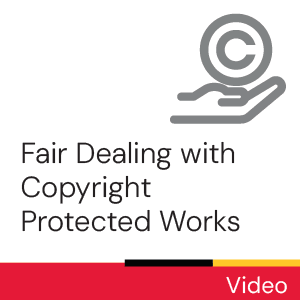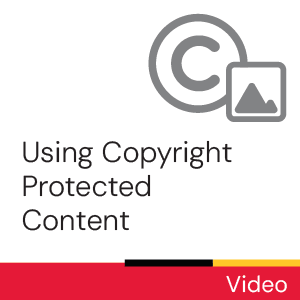Time commitment
Less than 2 minutes
Description
This video will explain how to stay copyright compliant when clipping online videos for educational purposes.
Video
Transcript
As you begin the process of creating digital media clips, it’s important to be aware of copyright law and to ensure you’re abiding by it. Copyright protection exists automatically for every work that is created, Whether or not it is explicitly stated on the work or marked with the copyright symbol. Copyright-protected works include all types of genres and formats Such as books, journals, computer software, movies, maps, music, images, videos and artworks This also includes content found on the internet.
Making copies of copyrighted works and sharing them with others is governed by the Canadian Copyright Act. In order to copy all or a substantial part of a work, The permission of the copyright owner is usually required. However, there are several ways you may be able to create and share clips from audiovisual works without infringing copyright. These include:
1. Fair Dealing
Copying under the fair dealing exception, which permits copying for some educational or research purposes. Fair dealing permits instructors and students to copy audiovisual clips, including the use of clips in coursework. Clips copied under fair dealing should not be posted on public websites like YouTube or shared with others outside of your course.
2. Copying as Permitted by the Terms of a License
The library subscribes to many collections of audio-visual content which includes videos and sound recordings and are subject to the terms of licenses. These terms are available to review on most platforms and generally permit educational and personal uses.
3. Copying and re-using works with a Creative Commons license
Creative Commons items are usually marked with this symbol. Materials that have a Creative Commons license can be copied without obtaining permission, provided you credit the creator of the work, and adhere to any conditions specified by the license. You may copy and use audiovisual content in your own creations as long as you follow the copyright requirements that apply to the content you are using. Remember -- it is never OK to remove or bypass digital locks in order to use a clip.
Want to learn more about using copyright-protected works in your creations? Visit this link.
Need Help? Email: library@uoguelph.ca
Get help via chat or email via the Library website, phone us at 519-824-4120 ext 53617 or visit the AskUs Desk
License

This work is licensed under a Creative Commons Attribution-NonCommercial-ShareAlike 4.0 International License.
Recommended
- Ask Chat is a collaborative service
- Ask Us Online Chat hours
- Contact Us

